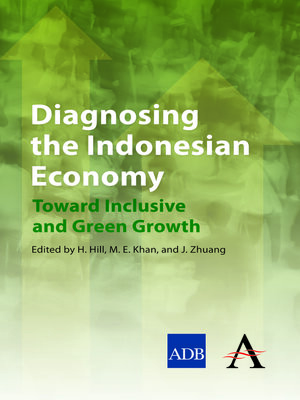Diagnosing the Indonesian Economy
ebook ∣ Toward Inclusive and Green Growth · The Anthem-asian Development Bank
By Hal Hill

Sign up to save your library
With an OverDrive account, you can save your favorite libraries for at-a-glance information about availability. Find out more about OverDrive accounts.
Find this title in Libby, the library reading app by OverDrive.



Search for a digital library with this title
Title found at these libraries:
| Library Name | Distance |
|---|---|
| Loading... |
'Diagnosing the Indonesian Economy: Toward Inclusive and Green Growth' discusses the critical constrains to inclusive economic growth in Indonesia. The volume includes a broad overview of Indonesia's development since the 1960s, and features an analytic framework for the study that aims to identify the most binding constraints. The chapters analyze macroeconomic management since the Asian financial crisis; the status of Indonesia's industrial transformation; the challenges pertaining to Indonesia's infrastructure; the situation of human capital and employment; the record on poverty reduction; the impact and status of the decentralization effort; and the challenges attendant to the country's environment and natural resources.
|'Diagnosing the Indonesian Economy: Toward Inclusive and Green Growth' commences with a broad overview of Indonesia's development since the 1960s. The analytical frameworks for the study, which were developed at Harvard University and ADB, are then used in an attempt to identify the constraints that most severely bind the country's development, and therefore the priorities for policy implementation and/or reform. The country's macroeconomic management and monetary policy since the Asian financial crisis is reviewed. The challenges of Indonesia's slow industrial transformation and small industry sector are described, as are their implications for poverty reduction efforts. The challenges Indonesia faces in developing its infrastructure are set out, e.g., the country's diverse topography, archipelagic nature, and monopolies. Human capital, an essential element in both growth and poverty reduction, is analyzed for the country, including the improvements in enrolments and gender balance, and the limitations the poor face to accessing education. Indonesia's record on poverty reduction is traced, as are the efforts to improve it. The links between employment creation and poverty reduction are presented, with a focus on the pressing issue of youth employment. The impact and status of the decentralization effort and efforts to fine-tune it are discussed. Last, the rather dismal status of the country's environment and natural resources management and the emerging impacts of climate change are summed up.
Indonesia's national development plan for 2005–2025 sets a vision of a country that is self-reliant, has a highly educated population with capable human resources, has no discrimination, and is prosperous enough to fulfil its population's needs. This will require high levels of economic growth that is both socially inclusive and environmentally sustainable. The volume identifies that in order to overcome the binding constraints to this growth, Indonesia needs to improve its infrastructure, enhance the education system to provide a more capable workforce, revive its manufacturing sector to open up employment, and facilitate these efforts through substantially improved governance and institutions. Furthermore, this growth must be accomplished in a manner that is harmonious and not destructive to the environment and natural resource base.







